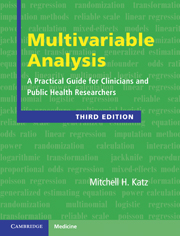Book contents
- Frontmatter
- Contents
- Preface
- 1 Introduction
- 2 Common uses of multivariable models
- 3 Outcome variables in multivariable analysis
- 4 Independent variables in multivariable analysis
- 5 Relationship of independent variables to one another
- 6 Setting up a multivariable analysis
- 7 Performing the analysis
- 8 Interpreting the results
- 9 Delving deeper: Checking the underlying assumptions of the analysis
- 10 Propensity scores
- 11 Correlated observations
- 12 Validation of models
- 13 Special topics
- 14 Publishing your study
- 15 Summary: Steps for constructing a multivariable model
- Index
4 - Independent variables in multivariable analysis
Published online by Cambridge University Press: 01 April 2011
- Frontmatter
- Contents
- Preface
- 1 Introduction
- 2 Common uses of multivariable models
- 3 Outcome variables in multivariable analysis
- 4 Independent variables in multivariable analysis
- 5 Relationship of independent variables to one another
- 6 Setting up a multivariable analysis
- 7 Performing the analysis
- 8 Interpreting the results
- 9 Delving deeper: Checking the underlying assumptions of the analysis
- 10 Propensity scores
- 11 Correlated observations
- 12 Validation of models
- 13 Special topics
- 14 Publishing your study
- 15 Summary: Steps for constructing a multivariable model
- Index
Summary
How do I incorporate my independent variables into a multivariable analysis?
Having determined, based on your outcome variable, the type of multivariable analysis you will be doing (Chapter 3), it is now time to consider how you will enter your independent variables into your multivariable model. While dichotomous variables can be entered into all multivariable analyses without special coding or transformation, there are special considerations for the treatment of nominal, interval, and ordinal independent variables. These are considered in Sections 4.2–4.4.
How do I incorporate nominal independent variables into a multivariable analysis?
Nominal independent variables, such as race or type of cancer, cannot be entered into a multivariable analysis, unless they are transformed. The reason is that the numeric codings for the variables have no meaning. You may have coded your variable 1=Caucasian, 2=African-American, but the numbers don't reflect a meaningful order. Therefore, any multivariable estimate of the change of going from one category to another is meaningless.
TIP
To incorporate nominal variables into a multivariable model transform it into multiple dichotomous variables.
To incorporate a nominal independent variable into a multivariable model you must transform it into multiple dichotomous variables. This process is usually called “dummying” by epidemiologists and biostatisticians. However, the terms “dummying” and “dummy variables” are slang. In manuscripts, you should refer to this process as creating multiple categorical variables (if you refer to it as dummying, you may, as I did, receive complaints from the reviewers of your article).
- Type
- Chapter
- Information
- Multivariable AnalysisA Practical Guide for Clinicians and Public Health Researchers, pp. 74 - 87Publisher: Cambridge University PressPrint publication year: 2011



